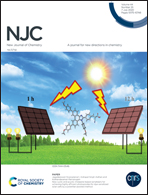Depositing reduced graphene oxide onto tungsten disulfide nanosheets via microwave irradiation: confirmation of four-electron transfer-assisted oxygen reduction and methanol oxidation reaction†
Abstract
Optimal morphology tailoring and complete utilization of the nanomaterial components are the effective parameters for improving the electrocatalytic activity of nanomaterials in both the oxygen reduction reaction (ORR) and methanol oxidation reaction (MOR). In the present work, a core–shell reduced graphene oxide (rGO) on tungsten sulfide (WS2), i.e., rGO@WS2 nanostructure was successfully prepared via microwave irradiation, which was found to catalyze the four-electron ORR in a 0.1 M KOH aqueous solution. The rGO@WS2 nanostructure showed an onset potential of 0.94 V and a 1.68-fold increase in the kinetic current density (−5.9 mA cm−2) for the ORR as, compared to the bare WS2 nanosheets. The superior performance of the rGO@WS2 nanostructure posits it as one of the efficient noble-metal-free ORR and MOR electrocatalysts. Predominantly, this work demonstrates the importance of an appropriate core–shell rGO@WS2 nanostructure in achieving high intrinsic activity for the four-electron ORR and MOR with significantly enhanced efficiency.



 Please wait while we load your content...
Please wait while we load your content...